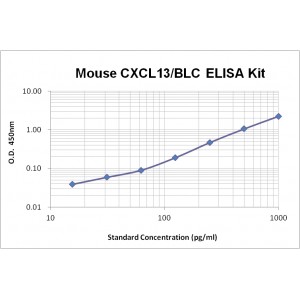More info
Assay Range | 15.6-1,000 pg/mL |
Sensitivity | 10.0 pg/mL |
Size | 96T |
Storage | Store at 2 - 8ºC. Keep reconstituted standard and detection Ab at -20 ºC |
Assay Principle | Sandwich ELISA |
Sample Volume | 100 µL final volume, dilution factor varies on samples |
Detection Method | Chromogenic |
Kit Components
1. Recombinant Mouse CXCL13 standard: 2 vials
2. One 96-well plate coated with anti-Mouse CXCL13 Ab
3. Sample diluent buffer: 12 mL - 1
4. Detection antibody: 130 µL, dilution 1:100
5. Streptavidin-HRP: 130 µL, dilution 1:100
6. Antibody diluent buffer: 12 mL x1
7. Streptavidin-HRP diluent buffer: 12 mL x1
8. TMB developing agent: 10 mL x1
9. Stop solution: 10 mL x1
10. Washing solution (20x): 25 mL x1
Background
C-X-C motif chemokine 13 (CXCL13), also known as B lymphocyte chemoattractant (BLC), is a small cytokine belonging to the CXC chemokine family. Encoded by the CXCL13 gene in humans, CXCL13 is a 109 amino acid (aa) precursor protein composed of a 21 aa signal peptide and a 88 aa mature protein. Mature mouse CXCL13 exhibits 46% aa identical to its human counterpart. CXCL13 is constitutively expressed in the B cell follicles of secondary lymphoid organs, and this expression is dependent upon the activity of lymphotoxin α/β. CXCL13 is also expressed in the pleural and peritoneal cavities and in ectopic lymphoid follicles of patients with rheumatoid arthritis.
The chemokine receptor CXCR5, also designated Burkitt’s lymphoma receptor 1 (BLR-1), is the primary receptor for CXCL13. CXCR5 is expressed in many different cells including B cells, follicular B helper T (TFH) cells, osteoblasts, podocytes, and a subset of skin-derived dendritic cells. It is reported that, in CXCR5-transfected HEK cells, CXCL13 can stimulate elevations of Ca2+ and pertussis toxin-sensitive activation of MAP kinase signaling cascades. CXCR3, a common receptor for monokine induced by IFN-γ (CXCL9/MIG), IFN-γ-inducible protein (CXCL10/IP-10), and interferon-inducible T cell alpha chemoattractant (CXCL11/I-TAC), is also activated in vitro by CXCL13. It is reported that the receptor for mouse CXCL13 is CXCR5, while human CXCL13 has been shown to bind to both CXCR5 and CXCR3. Functionally, CXCL13 is critical for secondary lymphoid tissue development and navigation of lymphocytes within the microcompartments of these tissues. Naive B cells expressing CXCR5 appear to migrate into lymphoid tissue under the influence of CXCL13. Depending on the degree of antigen exposure, various chemokine receptors on B cells will be subsequently up- and/or down-regulated, directing B cells to appropriate anatomical regions for activation. Concomitant to B cell migration, there is a specific subset of CD4+ memory T cells that are also CXCR5+. These cells migrate into lymphoid tissue in response to CXCL13 and provide help to resident B cells for antibody production via inducible costimulator-ligand interaction.


